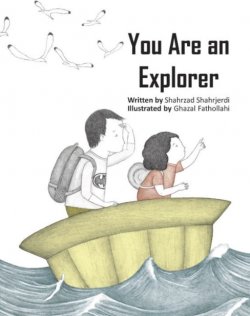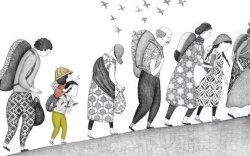Farzaneh Shahrtash, Iran

Review of You Are an Explorer by Shahrzad Shahrjerdi (illustrated by Ghazal Fathollahi). Tehran, Iran: Tuti Books: A Division for Children and YA Fatemi Publishing Co., 2019. Originally published as “تو یک جهانگردی” translated from the Persian by Mehdi Amiri. Also translated to Spanish by Lawrence Schimel as Somos Exploradores, published by La Maleta Ediciones, Llanera, Spain, 2020. [Daniela Stamatiadis]). Athens: Eκδόσεις Ίκαρος [Ikaros Publications], 2017.
Under the fire of guns and tanks:
- I was standing in a corner at our house and looking around. I had no idea what to do, but my brother was quickly packing our stuff into his school bag.
- “What should we do now?!” I asked him.
- “Would you like to be an explorer?!” He said to me while he picked up his hat from the shelf and put it on my head.
- “An explorer! But how?”
- “It’s all explained in this book. Don’t worry! I’ll read it to you myself, but only if you promise to listen carefully.”
- “I promise! I promise!” I said quickly.
- Those scary sounds could be heard again. “Can you hear this too?” I asked. “Shh! Pay attention to the book. It says here that we need a map.”
- “Does it say in the book where the explorers finally end up in?” I asked him.
- “I don’t know. I mean I haven’t read the whole book yet. Maybe they’ll end up in the city of explorers.”
So, the journey of these two little explorers begins.
This beautifully illustrated book, with exaggerated pictures of two unprotected children, deals with the issue of post-war displacement of children and their families. While the parents of these two explorers are absent for an unknown reason, the older brother is taking care of the younger sister by his creative thinking. He is trying to use the power of his imagination based on care, as a technique to face seemingly unendurable and oppressive situations. This technique might be quite familiar to young readers of the book. Many children use an “imaginary friend” as a way to cope with their fears of separation or death, to find a way through their immediate predicament, to keep going forward.
Migration–sometimes forced, sometimes deliberately chosen—is another situation for people all around the world, that requires problem-solving. This story might be a great opportunity for older children to explore and discuss the reasons and consequences of migration.
The children who discuss You Are an Explorer with you, or in your class, may not have experienced a real war, may not have been in any post-war situations, and may not have experienced displacement. Perhaps they haven’t even been in contact with those who have been through any of these circumstances, but they can still explore some relevant concepts in this book, opening dialogue with their peers. Relevant concepts might include: hard times, problem, insecurity, fear, responsibility, imagination, make-believe, resilience, hope, empathy, rescue, and shelter.

Since the focus of this story is on a crisis rather than a problem, it might be good to explore the difference between solving problems, overcoming crises, and coping with seemingly unendurable situations. The difference between a problem and a crisis is like the difference between an exercise and a discussion plan in Philosophy for Children (P4C). An exercise is for learning and practicing inquiry skills and attitudes using an isolated, relatively simple group of questions or problems; a discussion plan is for stretching those skills and attitudes in an interrelated, complex series of questions.
The following questions may be useful in a community of inquiry discussion in a refugee camp or in an online community with children who have recently experienced post-war situations, such as in Ukraine and Afghanistan:
- What is the difference between having a problem and having a crisis?
- Have you ever had a crisis? What helped you to endure it or overcome it?
- How did the brother in this story help his sister to go forward in her life?
- How important is imagination for people (both children and adults) in crises?
- What else is important?
- Can some crises be avoided? If so, which kinds?
- (How) can you be prepared for a crisis?
Although the terrible scenes in this book might not be suitable for young readers, the text tells us quite another story, which is not frightening to children. A facilitator can follow and explore these parallel stories at the same time, or separately.
You and your students may also notice that from the beginning, in many pages of the book, there is a disconnection between the brother and sister and the rest of the figures in the story, both adults and children, as if they are not seen or heard by the others. For example, even when the girl is sitting beside a few other children near their tent, there is no sign of communication or interaction, only silent drawing. Meanwhile, the brother is carrying the water all alone, to their tent; no adult is around to help. This may give the reader a sense of emotional and physical abandonment or isolation, even in the community of explorers. What other interpretations are possible?
At the end, the colorful picture of the class with hanging cranes as a symbol of hope and peace, along with our proud explorer author and her book, is not all that these children deserve; it is only the beginning of their journey to human rights—another philosophical concept important to explore. If no one upholds or protects a right, does it exist? Are there rights that belong to humans simply by being humans? If so, who is responsible to recognize and protect them?
There are many more things to explore in this evocative picture book, which unfolds emotional, social, and even aesthetic dimensions of war and forced migration.
Note: In 2021 You Are an Explorer won a Golden Plaque from the Bienále Ilustracií Bratislava [Biennial Illustration of Bratislava] and has been shortlisted for the top 50 (of more than 1000) titles in The Cheltenham Illustration Awards.
